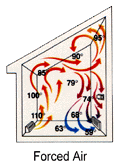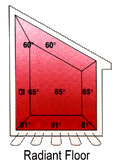|
|
|
|
|
|
Forced Air vs. Radiant Heat
What are the main differences between these two heating systems? Is it just cost, or does it go beyond that? We compare many different factors which you, the homeowner, expect or want from your heating system.
In a home which is heated by radiant heat, your body circulation will improve because your feet are warm. That isn't the case with a forced air system. The heat is near the ceiling, around your head. Chairs and walls keep warm without cold spots or drafts in a radiant heated home -- objects in a forced air home are only as warm as the air around them.


Radiant Heat keeps your furniture, drapes and painted walls extremely clean and keeps the floors dry. When the home is heated by blowing air; dust, dirt, grime, molds and other materials are blown from the ducts soiling the objects in the room.
Place furniture anywhere. There are no grills or baseboards with a radiant heat system. Hang drapery right to the floor. Install wood, tile, carpet, or any other floor coverings without fear of cold feet. Forced air can't come close to the flexibility of a radiant heating system.
Take a look at the following comparison table, and decide for yourself which system would be best for you and your family or your business.
|
Warm Air
|
Radiant Heat
|
| Warm air heaters heat air which then warms the surroundings where people live and work. In buildings where doors are opened regularly, high air exchange rates occur which result in extremely high heat losses. |
Radiant heat is not absorbed by the air, so it is ideal for buildings which have high air exchange rates. Radiant heat offers considerable energy savings over warm air systems, especially under otherwise difficult conditions. |
| Directing heat to working/living areas is difficult with warm air heaters. Consequently, a garage heated by warm air will have cold spots at the working level and wastefully high temperatures at the roof level. |
Radiant heat is transmitted by infrared waves and is directional. Radiant panel heating ensures that cold spots are avoided. |
| Drafts and natural convection currents make it difficult to control warm air movement within a building. As warm air rises to areas where it is not beneficial, heating costs also rise. |
Zone control of the radiant system permits flexible management, allowing selected areas to be heated to different temperatures as required. |
|
Warm Air
|
Radiant Heat
|
| Hot air rises. Therefore the ceiling of a home/workshop heated with warm air will be substantially hotter than the living/working area beneath. Poor roof insulation, a common problem in older buildings, will allow this heat to escape, further increasing fuel costs. |
Radiant heating minimizes roof heat losses. By keeping the heat at floor level and around the objects to be heated, the temperature at the ceiling level becomes cooler and substantially reduces the heat loss. |
| Warm air heats living/workshop space slowly. In order to be effective it is necessary to heat all the air in the building. While the air gets to the required temperature, extra fuel is burned and the work force remains cold. |
Radiant heat warms up cold bodies directly without heating the whole building. Consequently, radiant heating responds to the heating needs more quickly than warm air. The less frequent warm up periods save fuel and allow the heating system to match flexible, modern working arrangements. |
| Warm air heaters rely on movement of air to heat the living/work space. In areas where cleanliness is essential for production and other work, drafts from a hot air blower will stir up unwanted dirt and dust. In addition, rapid air movement actually has a cooling effect on the body. |
Radiant heating does not circulate air, therefore airborne particles are reduced. |
Back to Main How It Works Page
ANDERSON RADIANT HEATING
520 East McGlincy Lane, Suite 16
Campbell, CA 95008
Phone: (408) 378-3868
Fax: (408) 559-0818
© Copyright 2012 - ANDERSON RADIANT HEATING
Privacy Policy
|
|
|
|